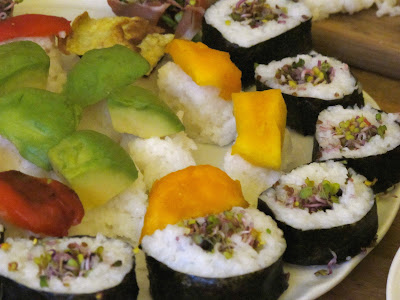There's something so inviting about sushi. Perfect little bundles, in a variety of colors and flavors. That soft, dense sticky rice texture, the sweet-saltiness, the burn of wasabi, the crunch of pickled ginger...
But then there are a couple of outright uninviting aspects of sushi: first, it's not cheap. Second, there's an element of déjà vu after a while, because pretty much every Parisian sushi restaurant is exactly like every other one. And not only that, they don't give much of a crap about the whole endangerment of Bluefin Tuna thing. I kind of do, so that kind of kills my buzz.
So I tried making sushi at home. Sure, it was easy enough to make some (occasionally wonky) cucumber and avocado rolls, but that's not novel for very long, either. I have to admit I love fish. So I made fish sushi at home, but felt a little awkward about eating raw fish whose path to my plate was completely mysterious to me, plus I didn't save all that much money, on top of it. So what was to be done?
His take was that you can really make sushi with anything. The key is seasoning your rice well with salt, sugar, and vinegar, and that gives you this really balanced base upon which pretty much anything can be eaten. After that, your imagination is the limit.
I planned with some good friends to have a sushi night sans fish. Then I pickled my own ginger in anticipation. That's how excited I was! We convened with vegetables, fruits, even some ham, and the sushification process began.
After lots of chopping, the sacrifice of Mat's hands to the beetroots, Rachel's masterful shocking of the peas in cold water after cooking (they were really shocked), and lots of rice-making and vinegar measuring and wasabi-mixing, we were ready for action.
Avocado Sushi
Roasted Red Pepper Sushi
Beet Sushi
Nori* Omelette Sushi
Green Pea Maki
Radish Sprout Maki
Mango Sushi
Jambon de Bayonne** Sushi
*Nori = the sheets of dried seaweed used to make maki rolls
**Jambon de Bayonne = a kind of raw aged ham, like Prosciutto, only Frencher
Everything was great. I forgot to bring over my chopsticks, though, so we ate with our fingers. That was actually kind of fun, too.
My favorites of the bunch were probably the Green Pea Maki, which went fantastically with wasabi, the Beet Sushi, which was particularly tasty with the pickled ginger, the Mango Sushi, which went surprisingly well with soy sauce for the whole salty-sweet thing, and the Jambon de Bayonne, whose delicate texture was reminiscent of fish. But overall, all the sushis were winners and we ended the night with full bellies. I highly recommend this as an evening with friends, as the vegetable cutting and dreaming up of possible sushis are activities best shared with others, and the whole process makes for a lovely evening. It really is just as exciting as fish sushi (and more creative), plus you can spend all the extra cash you saved on booze!
1 rather large ginger root
1 tablespoon course salt
3 cups rice vinegar
2 cups white sugar
5-6 whole peppercorns (I used pink, the original recipe called for black) - optional
5-6 whole cloves - optional
Peel the ginger, and slice into very thin slices, using either a mandolin or a very sharp knife. Cover the slices with ice water in a large bowl and allow to sit for one hour. Drain and dry thoroughly (a salad spinner works well).
Combine vinegar, sugar, peppercorns, and cloves in a saucepan and bring to a boil. Simmer for five minutes, and meanwhile try to avoid getting a big whiff, as it will hurt your nose. After simmering, pour the hot mixture over the ginger and store in a covered container (a glass jar works well) in the fridge.
Note: If you can use very young ginger, it will apparently turn pink after pickling. Older ginger, like I used, will stay beige, but if you want it pink, you can always boil some beet in your vinegar mixture.
Sushi Rice
Sticky rice
Water
Sake (or similar rice alcohol)
Rice vinegar
Salt
White sugar
Cook the rice according to package directions, adding about 1.5 times as much water as rice. If possible, substitute some of the water for sake, or another similar rice alcohol (I used Korean soju and it worked great). When the water has been absorbed, cut the heat but keep the rice covered, allowing it to continue cooking with steam. After about 15-20 minutes, concoct a mixture of vinegar, salt, and sugar, and mix this gently in with the rice, being careful not to break it (Mark Bittman suggests thinking of it as folding egg whites into batter), in a proportion of 1/2 cup awasezu (the name of the vinegar mixture) for every 2 cups cooked rice.
Tip: You can buy special plastic trays to help you mold the rice into the oblong sushi shape you get in restaurants, or you can just use ice trays to help you get a regular shape, even if it's not exactly the same. Get the rice out by banging the ice tray on the table.
For the maki, I find it easiest to use my fingers to spread a thin layer of rice over the nori, leaving 1/4 - 1/2 inch rice-less on on side, to seal the roll. Put a thin column of filling parallel to the rice-less strip but on the opposite side of the sheet of nori, then start rolling on that side. Cut with the sharpest knife you've got.








1 comment:
these are great recipes... and really detailed... thanks for these! :D
http://zushistravelguide.blogspot.com/2010/06/if-you-may-have-noticed-my-pen-name-you.html
Post a Comment